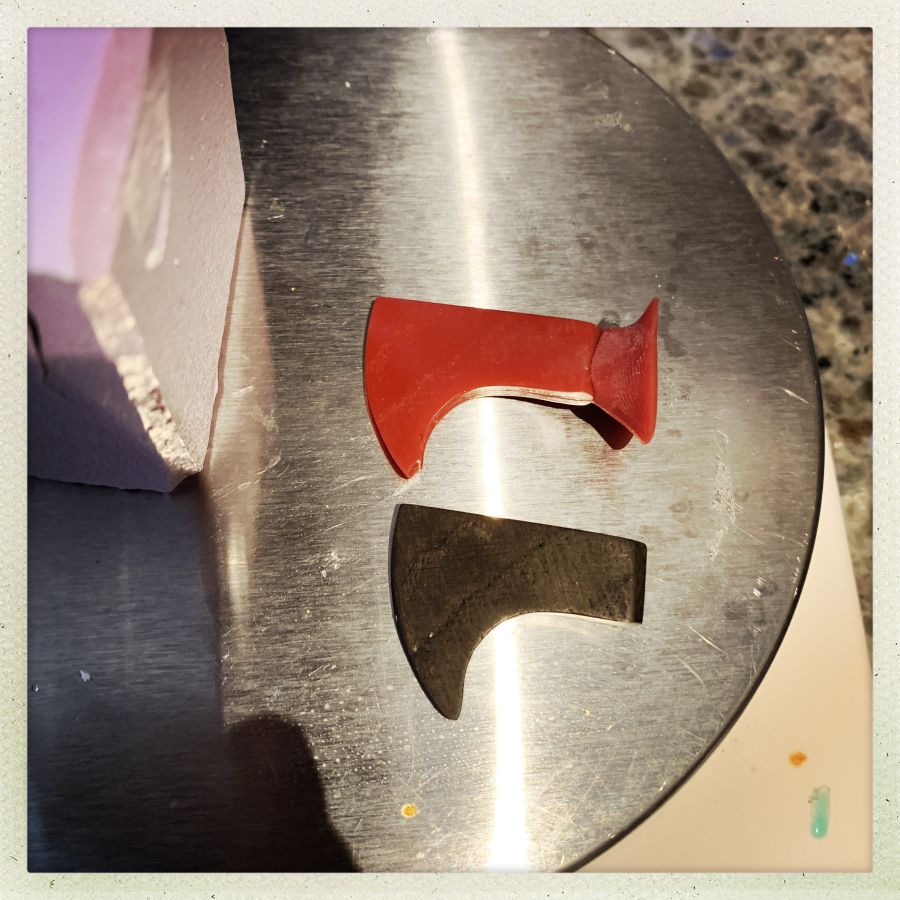Since the forge is down, I don’t have a place to smelt metal, which has put a big crimp in my silver casting projects.
But I can still noodle around:

I made a little viking-style ax head out of resin-soaked bog oak. Then, I made a silicone mold from that (far left, the purple thing) and you can see the detail that the silicone captures in the wax; it’s basically molecule-level accurate.
The blobby thing at the bottom of the wax is the pouring inlet. A while into doing this sort of thing, I realized that I need to hold the item still in the silicone and I may as well dual-purpose that part of the process. I use a bit of modeling clay to build a base that simultaneously holds the item and forms the eventual pouring inlet.
When you figure out the pour of an item, you have to do some thinking to imagine how the air is going to move in the mold (since I am not yet using vacuum molding on my pours) also, how you are going to finish/machine the thing. When I cast silver, it’ll be stronger than the bog oak, so I may drill a hole large enough to fit an axe handle (of bog oak, naturally!) into the metal. Or not, I don’t know. So some of the dimensions that look thick will thin down as I sand and shape the final version.
The great thing about the lost wax process is that you can alter the wax easily enough, and if you screw it up you just re-melt the wax and re-pour. You can see at the end of the axe edge, there is a small bubble; I re-poured the wax and was a bit more careful to tilt the mold to let the bubbles out. Molten hot silver is heavier and it’ll fill that area just fine, but I may tip the mold by putting something under that side when I pour it.
Another thing I think I’ll do is carve some runes in the wax along the side of the axehead. Why not? If I screw up, I can just do it again.

Resin-soaked bog oak is delightful stuff to work with. It’s strong, light, grinds and files cleanly, and polishes right up. If any of you have a project that you think would be set off nicely with a small chunk of resin-soaked bog oak, contact me and I’ll send you some. It’s embarrassing how much material I have to cut away to make a bowl, so I have a pile of weird cut-offs of burl wood and bog oak that are too small for knife handles or bowls, but too big to throw away. It’s super easy to work with a coping saw or a pin jigsaw, so I can throw together stuff like the axe head pretty quickly – about 10 minutes.

So Marcus, we must know: how much of this project was fueled by the desire to use the awesome title for this blog post?
Nice. That is a great shape. I think that’s called a sprue? Anyway that’s what I’ve always called it. This is a cool project, I will be fascinated to see what you do with it.
preparing for werewolves?
preparing for werewolves?
Little wee werewolves!
Suitable for a Wee Free Man. A good simple shape.
That’s some fancy noodling around. Is that shape what is known as a skeg ax? Viking age silverwork is masterful. The engraving and niello work on some of the objects in various museums in Great Britain is truly high art, in addition to being superbly crafted.
ULFMÆRXT?
Tethys@#6:
Is that shape what is known as a skeg ax?
Yes, or a “bearded axe”
Most viking axes were short, designed for fast fighting in close, though there were always a few who favored great big two-handed axes that could inflict fearsome damage.
Viking age silverwork is masterful. The engraving and niello work on some of the objects in various museums in Great Britain is truly high art, in addition to being superbly crafted.
If you ever make it to Oslo, the viking museum is a must. There is some lovely jewelry there, as well as (naturally) the longships. I’m not sure if the vikings did lost wax as much as soapstone molds or re-usable earthenware molds.
I was thinking more of the initials of a re-enactor on the side, or something like that. I did a few mods to some of the waxes and we’ll see how it comes out. It’s going to depend more on my pouring, at this point, than anything else.
Luckily the Swedish Institute of Minnesota had an exhibit of Viking and Vendel age artifacts from Uppsala. Seeing all the fine details in person was great! I still can’t figure out how they managed to solder all the pieces together without a tiny blowtorch.
The Vendel/Anglo-Saxon gold and garnet style is even more technically complex than the silver and niello of Viking age metal smiths. I would love to see any of the ships in person. I am especially intrigued with the carved items, textiles, and textile tools found with the Oseburg Ship. They too are simply astounding art, in addition to being very technically advanced for early medieval Europe.
You might want to get a product called debubbleizer if you plan to try more detailed castings. It’s an inexpensive surfactant for silicone, rubber, and wax. Dental labs use it routinely when pouring up impressions, models and investing wax patterns, though they also use a vibrator to help any air bubbles escape.
The vowels of the various runic alphabets are tricky. My previous is in transitional age elder futhark except for the æ. (The U and L should be flipped top to bottom, but are otherwise the same in runic) Wolf-marked seems like the obvious runic kenning for a wee werewolf skegax made by Marcus.